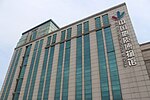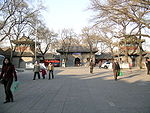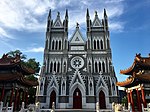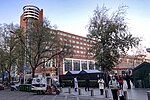The Geological Museum of China (Chinese: 中国地质博物馆), built in 1916, is a geological museum, boasting 200 thousand specimens.
This museum is located in the Xisi area of Beijing and opened on October 1, 1959. It is the earliest geological scientific museum of China.
At present, the Geological Museum of China has more than 100,000 geological specimens. Many of them are precious items reputed as "National Treasures", such as "the Giant Shandong Dinosaur"(Shantungosaurus) fossil, the most complete dinosaur fossils extant in the world excavated from Liaoning; the fossils of primitive birds that were found in the west of Liaoning Province, which has the essential values to the research on birds of the area; the teeth fossils of Yunnan Yuanmou Man, which shifts the appearance of human beings in China to a much more earlier time; the stoneware, stone pearls, bone needles and bone decoration unearthed from the site of the Upper Cave man at Zhoukoudian in Beijing; a cinnabar crystal of 237 grams that is called as "King of Cinnabar"; and more than 60 new mineral products that were found in China, and so on. Basic displays of the museum are composed of five exhibition halls, namely, the exhibition halls of geological resource, global history, stratum paleontology, mineral rocks and diamond, with an exhibition area of 2,500 square meters. The hall of geological resource introduces in different catalogues and classifications the abundant mineral products and other geological resources in China; the hall of global history introduces earth formation and construction, earth inner motive power geological action, earth outer power geological action and earth washing action; in the stratum paleontology hall, there are the special exhibitions of Zhendan biome, insect fossils, fish fossils, egg fossils, and the Upper Cave Man—ancient creatures and their characteristics of different geological eras.












